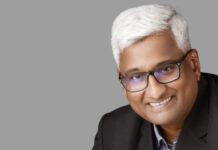Madhavi Lall, Managing Director, Head – HR, India at Deutsche Bank. She has worked with companies like Accenture, Standard Charted Bank, Colgate Palmolive, ABN Amro Bank, HCL-Hewlett- Packard Ltd. and has around 30 years of experience. She completed her MBA from XLRI Jamshedpur and has pursued a Master’s degree in Mathematics from St. Stephen’s College. She has also completed a Leadership management course from the University of Oxford.
Madhavi was conferred the “Women Leadership Award” by the Institute of Public Enterprises-BFSI. She is a founding member of the HR Committee for FICCI. She has also been conferred the Distinguished Alumnus Award by XLRI in 2016
Q- You have almost 3 decades of experience in HR working with fortune 500 companies like Deutsche Bank, Accenture, Standard Chartered Bank and ABN Amro etc as Chief of HR. Tell us more about your time at Deutsche Bank?
If I were to summarize, for me personally, Deutsche Bank is a brilliant place to work in. The culture is open and innovation is warmly welcomed. The bank encourages staff to constantly come up with new ideas to build efficiency, effectiveness and create value in our journey to be the best place to work.
Our Positive Impact campaign, for instance, underlines the strategic relevance of focusing on client relationships. The reason we come to work every day is to create a positive impact on the plans, ambitions and dreams of our clients and colleagues alike. To help create better, more successful companies and enable businesses to get off the ground, expand and reach further. So that people can take care of the future, for themselves and for their families. Enabling economic growth and societal progress lies at the heart of our Positive Impact campaign.
From the perspective of my role in the Bank, the senior leadership is very committed to building an inclusive workplace and genuinely caring for people. We foster an inclusive and respectful work environment where every employee can be authentic, contribute his or her best work, and succeed based on merit. We have been able to introduce leading people policies like gender neutral care giverleave, fully sponsored childcare assistance etc. We are also working towards constantly improving our employee well-being proposition through a series of initiatives, and targeted policy interventions. Our vision in the HR function is to continue to work in partnership with businesses to create an environment where people can thrive and are enabled to deliver sustainable organizational performance.
Q- How has your leadership style evolved throughout your career, and how is that evolution impacting on your line of work?
When I started my career the leadership styles that worked, tended to be directive and everybody expected the leader to have all the answers. Over the years, effective leadership has been collaborative, focused consensus building and inclusive.
I would say that the big change for me has been building a lot more inclusion, and more so of different thoughts and ideas. We have almost five generations in the workplace today and the best success for any unit, function or company comes with leveraging all the diverse ideas.
Being in HR this has helped me personally understand the uniqueness of each human being- what will motivate one person may not motivate another. With my personal experience, I am hopefully also able to help managers create deeper and meaningful impact in their leadership journeys.
Q- The banking industry has been going through transformation due to progressive economic reforms, changing demographics and technological developments. What are the workforce challenges in banking sector and how do you see the future of talent in your industry?
Digitisation, automation and artificial intelligence are disrupting the world of work. The kind of skills organizations would require will change with significant implications on individual career paths. Employees entering the workforce are looking at long careers meanwhile the half-life of skills is falling rapidly. In today’s market we need to learn and unlearn quickly if we want to stay relevant. Financial services likes other industries is going through a transformation, driven by competition, regulation and advancements in technology. Banks could face their own Kodak moment by falling into irrelevance if they fail to keep pace with rapidly developing fintech technologies and an increasing demand for a superior customer experience.
The shortage of talent, demands of multiple generations, virtual teams and continuous changes in regulation – all of these forces have created an inflection point as organizations look to build an engaged workforce. All this is happening against the backdrop of companies themselves facing constant digital disruption.
Leaders will need to respond to these imperatives through playing a fundamental role in creating a fit-for-purpose culture. They will have to manage flexible teams, encourage employees to change mindset about type of employment and ways of working. They will also have to mentor employees and help them navigate radically different career paths and seek opportunities in a project oriented business model.
Q- There is a dynamic paradigm shift in L&D since past few years due to the rise of digital training solutions, multigenerational workforces and gig economy. How do you see the future of L&D in the financial sector?
Employees can access a varied set of learning tools at their fingertips these days, so the problem we need to solve for is-how do we provide individualized, relevant and engaging content in real time? The rise of new employment models, presence of multiple generations at the workplace, varied learning styles etc. is influencing the role of the learning function. The key challenge will be empowering employees to reskill and reinvent themselves to support flexible career journeys through being highly valued business partners.
The role of a learning function is moving from a content creator to a content curator with a sharpened focus on user experience.
Q- What is your L&D strategy to leverage the effectiveness of training programs?
In today’s world we are learning every minute considering the amount of information and platforms we constantly access. Content is easily accessible on demand in the format of choice. Drawing a clear correlation between a training program and the desired change in employee behavior is posing to be a real challenge.
We continuously adapt our learning proposition to dynamic needs and changing market requirements. Our development offerings target varied stages of an employee lifecycle – new joiner training, personal development training, leadership development programs, high potential programs etc. The impact of each of this is measured using different parameters. There could be pre and post assessment, in some cases 30 day / 60 day feedback etc. One of the critical measures of success is the feedback from the business on the impact seen on the day to day work. User hits on virtual content and sustained participation in programs also helps us track engagement with the learning agenda.
Employee testimonials or stories of transformation are another powerful feedback tool that works very well for targeted leadership programs.
Q- How have you developed the culture of continuous learning in Deutsche Bank to align the talent performance with business objectives?
Continuous learning has to be embedded in the culture of the organization otherwise we may become irrelevant to the workforce of the future.
At Deutsche Bank, we follow an integrated approach for managing performance and development, based on regular, meaningful two-way conversations, which encompass development, career pathing and future recommendations along with other performance parameters like contributions and capabilities. We encourage a dynamic dialogue between managers and employees-matching employee aspirations and development areas to organization goals and skill requirements
Employees are provided with multiple development opportunities within the organization. The bank follows 70:20:10 model-mixing different learning methods is the best guarantee for effective learning. 70% of the learning is through on the job experience, 20% of the learning is through relationships, network and feedback and 10% learning is delivered through formal training interventions
We also have a strong digital curriculum making sure that fast, effective learning is available for everyone, everywhere and at any time. We offer handpicked learning resources in a range of formats including virtual classrooms, podcasts, videos and articles-many of these take less than 5 minutes to complete and are easily accessible
Q- Keeping the employees excited about trainings is challenge, how can HR leaders get them enthusiastic and eager for learning?
In the LinkedIn Workplace Learning Report 2018, getting employees to make time for learning has moved up to be the #1 challenge facing talent the learning function. This emphasizes the need to be innovative and adaptive to keep employees engaged and eager to learn. For example: in Deutsche Bank we introduced Mystery Coffee, using smart algorithms, this initiative has helped over 12,700 colleagues around the world to make connections, expand their networks and share expertise.
In the organization of the future, the ability to adapt skills to changing workplace needs will be critical. There is a constant need to identify and measure skills, match them to the right jobs and provide adequate support to unleash potential. This is only possible if learning strategy continues to be dynamic and social.
According to research, an average employee has 24 minutes a week for formal learning- the future would be embedding learning into work platforms to allow for just in time, adaptive, self-paced content. This will be the key to staying relevant in the rapidly changing world of work.
Q- What are top trends for L&D in 2019 and near future?
Below are few L&D trends that I’m pretty excited about for 2019 and near future.
- Micro learning will continue to remain a trend. Providing learning in chunks easily digestible to employees will help them learn even if they have less time.
- Reverse mentoring is also coming up as an important tool to manage a multi-generational workforce.
- Learning will become more and more personalized-technology will create the ability to craft individualized offerings to suit different learning styles, formats and will be delivered through varied modes of content.
- Integration of learning into a regular workday will be another important trend-imagine leveraging on cloud connected mobile and wearable devices to create virtual learning experiences so seamless that they are almost invisible.
- As we move to a project-based business model, there will be a need to come up with innovative approaches that move beyond the focus on the individual and help develop high-performing teams
Q- Any last few words for our readers?
In the current fast paced environment, in my view, we need to be able to build three key skills:
- Ability to read the trends in the marketplace and technology that will impact our roles.
- Adaptability.
- Accepting ambiguity as a way of life.
There are many ways we can build these skills – I would say find the learning option that best suits you as an individual, and go for it.
Keep learning- keep thriving!
Thank you Madhavi!









